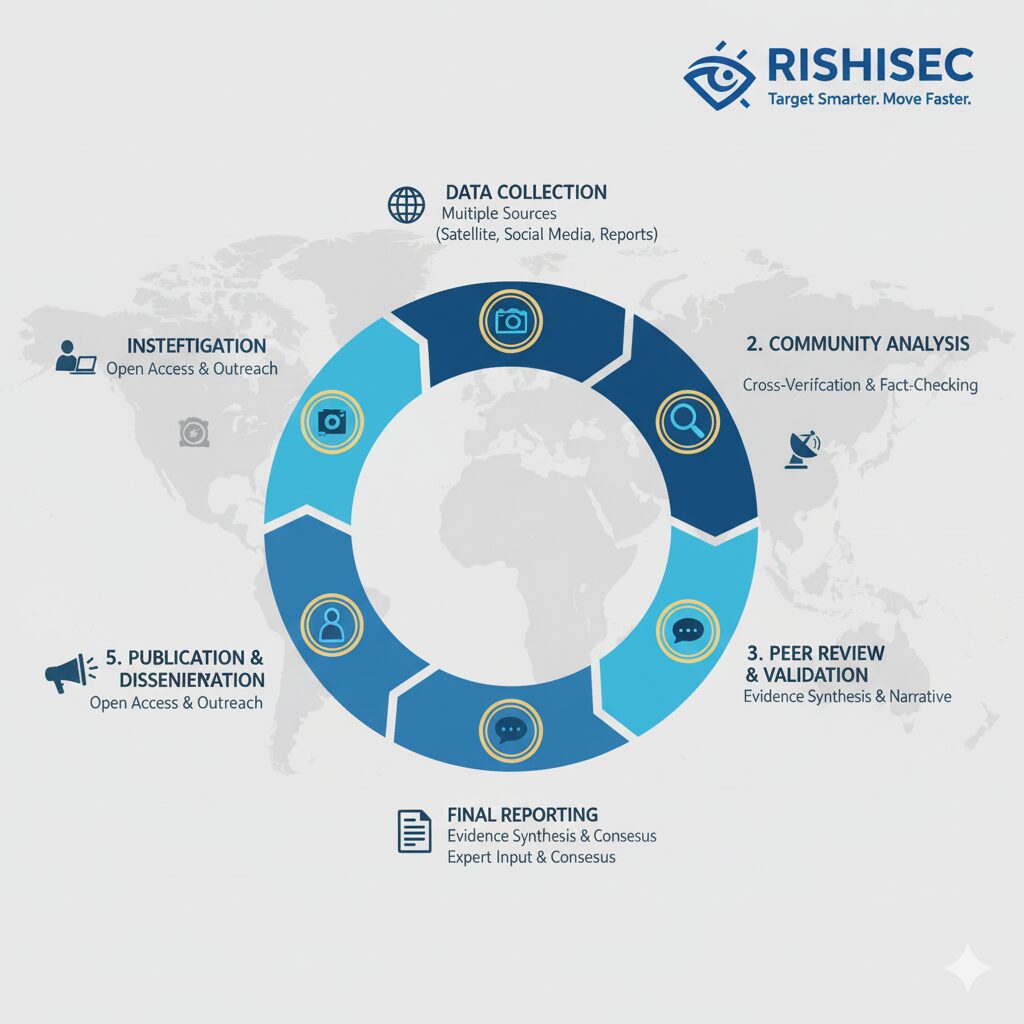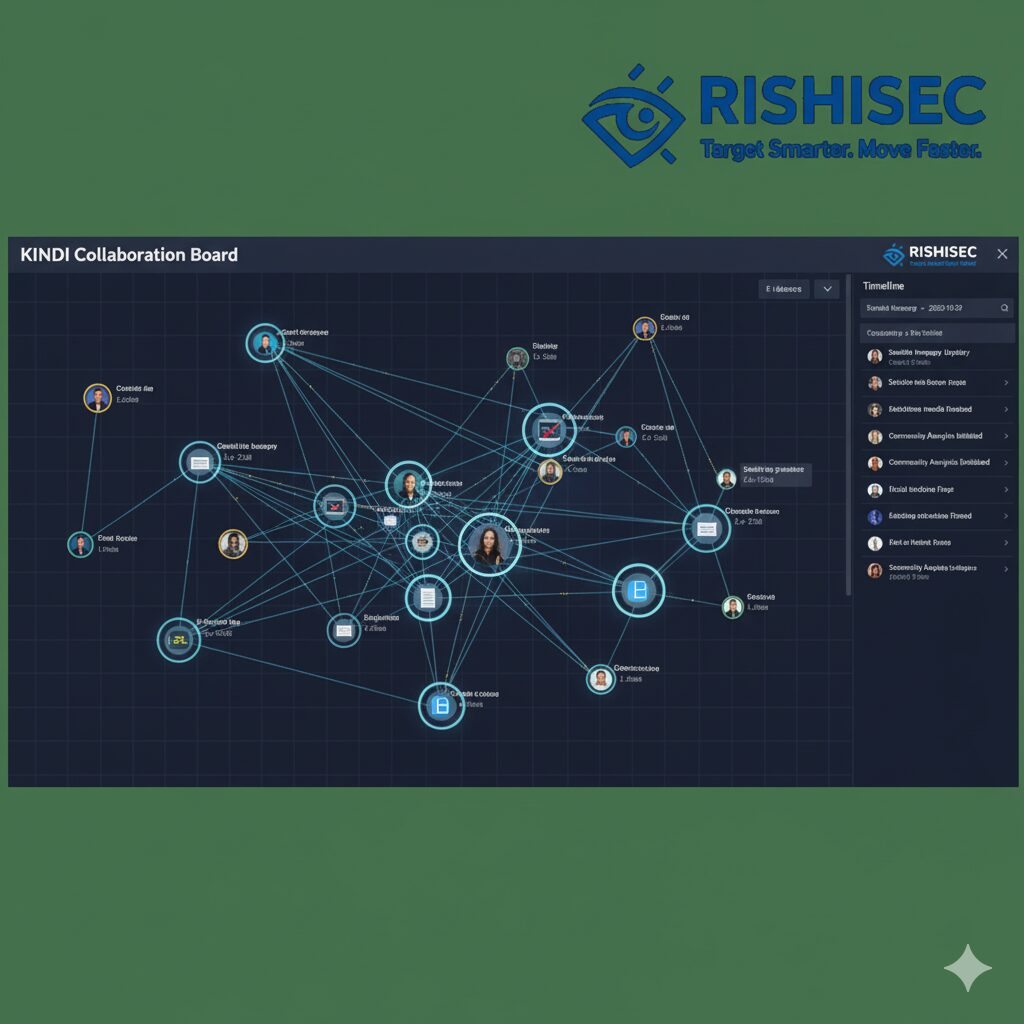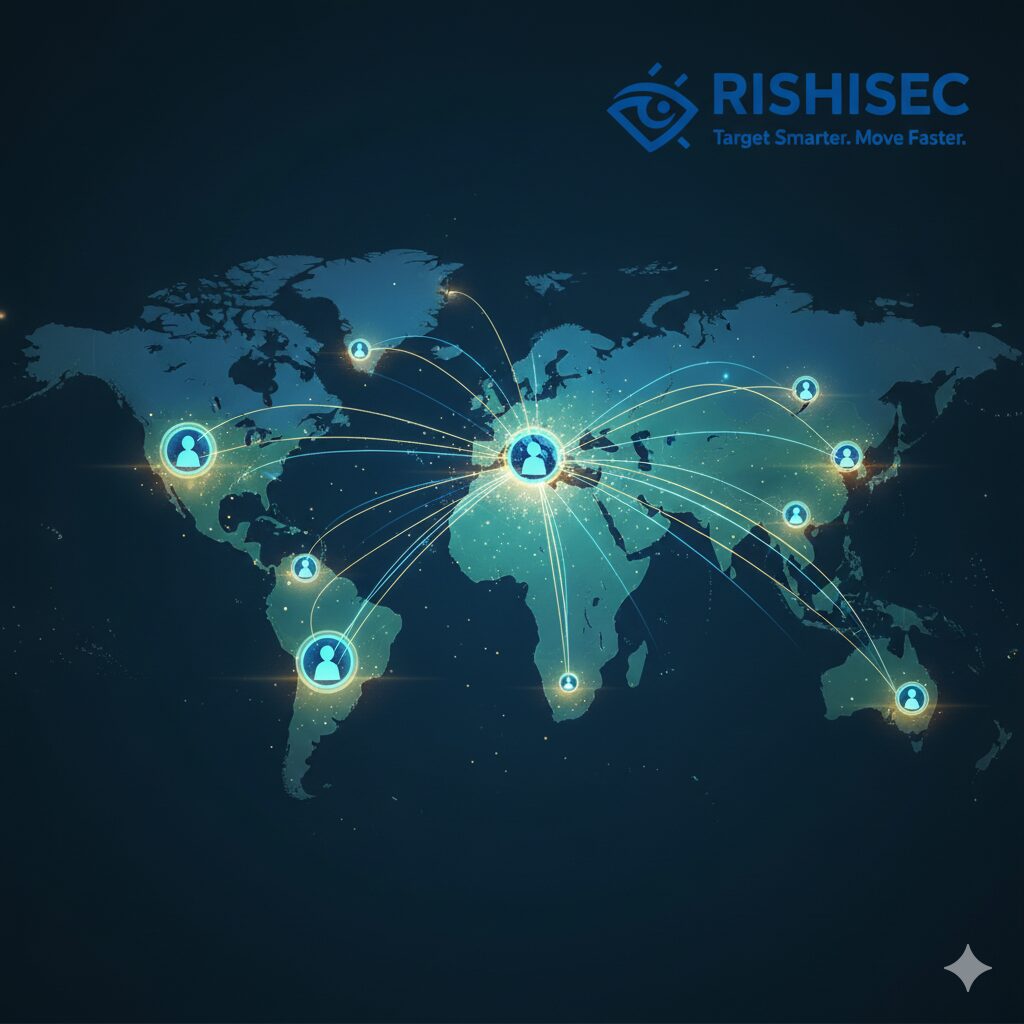From war zones to corporate boardrooms, truth now has thousands of eyes. The traditional model of investigative journalism, where small teams work in isolation for months, has been transformed by crowdsourced OSINT. Today, distributed networks of citizen investigators collaborate across borders to verify incidents, expose corruption, and document human rights violations faster than any single organization could achieve alone.
Crowdsourced OSINT refers to collaborative open-source intelligence gathering where multiple investigators contribute data, analysis, and verification to shared investigations. This approach has reshaped verification culture fundamentally. Organizations like Bellingcat have built their entire methodology around community contributions, while Forensic Architecture combines academic research with public participation. Even Reddit’s investigative communities have successfully identified perpetrators and verified contested events.
The power lies not just in numbers but in diversity. When investigators from different time zones, cultural backgrounds, and expertise areas collaborate, they bring unique perspectives that strengthen verification. A researcher in Asia might recognize architectural features that European analysts miss. A linguist can verify audio authenticity while a weapons expert identifies ordnance types. This collective intelligence model produces more robust findings than traditional siloed approaches.
Platforms like Kindi support these collaborative investigations through link sharing and graph-based intelligence visualization. Teams can work simultaneously on different aspects of an investigation while maintaining a unified evidence structure, which accelerates verification timelines significantly.
The Evolution of Citizen-Led Investigations
The Arab Spring marked a turning point for crowdsourced verification. When protesters documented uprisings on social media, traditional newsrooms struggled to verify the flood of user-generated content. Citizen investigators stepped in, using open-source tools to geolocate footage, verify timestamps, and corroborate witness accounts. This grassroots verification network proved more agile than conventional media organizations.
The Ukraine conflict accelerated this evolution dramatically. Within hours of Russia’s 2022 invasion, distributed networks of OSINT investigators were tracking troop movements, documenting war crimes, and verifying claims from both sides. Flight tracking enthusiasts monitored military aircraft, satellite imagery analysts examined battlefield changes, and social media experts verified frontline footage. The collective output rivaled intelligence agency capabilities.

Gaza presented different challenges. With restricted journalist access and competing narratives, crowdsourced investigators became primary sources for international media. They verified building identifications, tracked munitions types, and documented civilian impact through collaborative analysis of limited available footage. This work directly influenced human rights investigations conducted by international organizations.
The democratization of intelligence tools made this possible. Software that once required institutional licenses became freely available. Cloud computing eliminated hardware barriers. Online communities shared techniques and training resources. Suddenly, motivated individuals possessed capabilities previously reserved for government agencies and major news organizations.
Why Crowdsourced Verification Works
The many eyes principle provides redundancy that strengthens confidence levels. When ten investigators independently verify the same claim using different methods, the collective conclusion carries more weight than any single analysis. This redundancy also catches errors quickly; if one investigator makes a mistake, others typically identify the problem during peer review.
Diverse data sources create stronger findings because different evidence types corroborate each other. Satellite imagery confirms what social media footage suggests. Flight tracking data aligns with eyewitness accounts. Leaked documents match patterns visible in public records. When multiple independent evidence streams converge, verification confidence increases dramatically.
Transparency and peer review distinguish crowdsourced OSINT from traditional intelligence work. Most collaborative investigations publish their methodologies openly, allowing outsiders to challenge findings. This accountability mechanism reduces bias and improves accuracy. If your work will face public scrutiny, you document more carefully and verify more thoroughly.
Speed represents another critical advantage. Traditional investigations require proposals, approvals, and resource allocation before work begins. Crowdsourced efforts start immediately when incidents occur. Within minutes of breaking events, distributed investigators begin collecting evidence, organizing findings, and sharing insights. This rapid response captures time-sensitive information that might otherwise disappear.
Essential Platforms and Open Data Sources
Social Media as Primary Evidence
Twitter, Telegram, and Reddit serve as primary sources for field evidence and firsthand footage. The challenge lies in verification rather than collection. Reverse image search tools like Google Images, TinEye, and Yandex help identify recycled or manipulated content. Timestamp verification requires examining metadata, shadow analysis, and weather records to confirm when footage was actually captured.
Geolocation remains fundamental to social media verification. Investigators compare visible landmarks, building architecture, street signs, and terrain features against satellite imagery and street view databases. Even partial matches can narrow locations significantly. Cross-referencing multiple posts from the same incident helps triangulate exact coordinates.
Platform-specific forensics matter because each social network handles media differently. Twitter strips some metadata but preserves others. Telegram channels sometimes retain original file information. Understanding these technical details helps investigators extract maximum value from social media evidence while recognizing limitations.
Geospatial and Metadata Sources
OpenStreetMap provides detailed mapping data created by volunteer contributors worldwide. Unlike commercial mapping services, OSM data is freely downloadable and modifiable. Investigators use it to identify building footprints, road networks, and infrastructure that help verify locations visible in photos or videos.
Wikimapia combines mapping with crowdsourced annotations. Users tag buildings and locations with descriptive information, creating a knowledge layer over satellite imagery. This proves invaluable when trying to identify specific structures or understand local context in unfamiliar regions.
UNOSAT and ACLED provide curated datasets for humanitarian and conflict analysis. UNOSAT offers satellite imagery analysis for crisis situations, while ACLED maintains comprehensive databases of political violence and protest events. Integrating these authoritative sources with crowdsourced findings strengthens overall analysis quality.
Collaborative Analysis Tools
Kindi excels at link visualization and collaborative tagging for distributed investigations. Multiple analysts can contribute to the same evidence graph simultaneously, adding nodes for entities, connections between data points, and annotations explaining significance. The platform maintains version history, so teams can track how investigations evolve and who contributed which findings.

Google Sheets and Airtable offer simpler alternatives for shared annotation and data organization. Many collaborative investigations use spreadsheets to track evidence items, assign verification tasks, and maintain chain of custody documentation. While less sophisticated than specialized OSINT platforms, these tools provide accessibility and familiar interfaces.
Jupyter Notebooks enable reproducible analysis when investigations involve data processing or statistical analysis. Investigators can share code, visualizations, and methodologies in formats that others can replicate and verify. This transparency strengthens findings and allows continuous improvement of analytical techniques.
Case Studies: Collective Investigations in Action
Bellingcat’s MH17 investigation exemplifies crowdsourced verification at its finest. After Malaysia Airlines Flight 17 was shot down over Ukraine in 2014, Bellingcat coordinated hundreds of volunteer investigators who analyzed social media posts, satellite imagery, and witness accounts. The community identified the specific Buk missile launcher responsible, tracked its movement from Russia into Ukraine, and connected it to Russian military units. This crowdsourced investigation ultimately contributed to the successful prosecution of criminals.
The Syrian Archive preserves evidence of war crimes through collaborative documentation. Volunteers worldwide help verify, catalog, and preserve video footage from the Syrian conflict. The archive has collected over three million digital evidence items, creating an invaluable resource for future accountability efforts. This work demonstrates how documenting state violence with OSINT can create permanent records even when perpetrators try to suppress evidence.
Local journalists have used crowdsourced OSINT to uncover police misconduct during protests worldwide. During the 2020 George Floyd protests, distributed networks of investigators verified police violence incidents by matching footage with publicly available body camera videos, news broadcasts, and multiple witness perspectives. The collective documentation influenced policy discussions and criminal investigations.
These successes share common patterns: clear coordination mechanisms, transparent methodologies, rigorous verification standards, and tools that facilitate collaboration without compromising evidence integrity. Organizations planning crowdsourced investigations should study these case studies to understand what makes collective intelligence work effectively.
Challenges of Collaborative Investigations
Disinformation poses the primary threat to crowdsourced verification. Bad actors deliberately introduce false evidence, manipulated imagery, or misleading context to contaminate investigations. Without proper verification protocols, collaborative projects can amplify misinformation instead of revealing truth. This challenge requires strict evidence standards and multiple independent verifications before accepting any finding.
Mislabeling and incomplete evidence create persistent problems in fast-moving investigations. Contributors may tag footage with incorrect dates, misidentify locations, or make unwarranted assumptions about what evidence shows. Establishing clear tagging conventions and requiring minimum documentation standards helps mitigate these issues.
Verification standards must strike a balance between speed and accuracy. Crowdsourced investigations often happen in real-time during unfolding events, creating pressure to publish findings quickly. However, rushing verification increases error rates and damages credibility. Successful projects establish tiered confidence levels, clearly distinguishing between preliminary observations and fully verified conclusions.
Security concerns affect both contributors and subjects. Citizen investigators in authoritarian countries risk arrest or harassment for participating in documentation efforts. Meanwhile, publishing findings about ongoing operations can endanger people visible in evidence. Collaborative projects need secure communication channels, anonymity options for contributors, and careful consideration of publication timing.
The need for moderation increases with project scale. Larger collaborative investigations attract trolls, conspiracy theorists, and well-meaning but unqualified contributors. Effective moderation requires clear participation guidelines, experienced coordinators who can evaluate contribution quality, and sometimes private working groups for sensitive analysis.
Building a Crowdsourced OSINT Team
Clear role definitions prevent duplication and ensure comprehensive coverage. Data collectors focus on finding and preserving evidence. Analysts specialize in specific domains like geolocation, weapons identification, or language translation. Verifiers cross-check findings using independent methods. Reporters synthesize verified information into coherent narratives. When everyone understands their responsibilities, collaborative investigations run more efficiently.
Safe communication channels protect both operational security and participant safety. Signal provides end-to-end encrypted messaging for team coordination. ProtonMail offers secure email for document sharing. Self-hosted platforms like Mattermost or Rocket.Chat give teams full control over their communications infrastructure. Choose tools appropriate for your threat model and participants’ technical capabilities.
Using Kindi to manage roles and track investigative threads creates accountability while maintaining flexibility. Administrators can assign permissions based on contributor experience, track who verified which findings, and maintain audit trails for evidence handling. The platform’s visualization capabilities also help teams understand investigation structure and identify gaps in coverage.
The Future of Open Data Journalism
AI-assisted verification will transform crowdsourced investigations over the coming years. Machine learning models can already detect deepfakes, identify manipulated imagery, and flag inconsistencies that human analysts might miss. These tools won’t replace human judgment but will enable faster preliminary screening, allowing investigators to focus attention on the most promising leads.
Community-driven fact-checking is evolving beyond simple true-or-false determinations. Platforms now support nuanced verification that captures uncertainty levels, conflicting evidence, and context dependencies. This sophistication better reflects investigative reality while maintaining public accessibility.
Integrating platforms like Kindi for AI-supported verification pipelines combines human expertise with machine efficiency. Automated systems can monitor multiple sources simultaneously, flag potentially relevant information, and perform initial classification. Human analysts then apply contextual understanding and ethical judgment to generate final conclusions. This hybrid approach maximizes both speed and accuracy.
Ethical frameworks for citizen OSINT are maturing as the field professionalizes. Organizations like the Citizen Evidence Lab develop standards for evidence handling, participant protection, and responsible disclosure. As crowdsourced investigations increasingly influence legal proceedings and policy decisions, adherence to these ethical standards becomes critical for maintaining credibility.
The barrier to entry continues dropping as tools become more user-friendly and training resources multiply. What once required technical expertise now comes with guided interfaces and tutorial systems. This accessibility expansion means more diverse voices contributing to verification efforts, bringing perspectives that enrich overall investigation quality.
Truth, Verified by Many
Crowdsourced OSINT represents more than just efficient investigation; it embodies a fundamental shift in how societies pursue accountability. Open data democratizes access to information that powerful actors once controlled exclusively. Collaborative verification distributes the burden of truth-telling across communities rather than relying on institutional gatekeepers alone.
Responsible collaboration requires striking a balance between openness and security, speed and accuracy, and technological capability and human judgment. The most successful crowdsourced investigations embrace verification ethics, respect participant safety, and maintain clear accountability standards throughout their work.
Ready to start your subsequent collaborative investigation? Try Kindi for AI-powered link analysis that brings your distributed team together and accelerates verification workflows.
Want to build stronger OSINT skills for collaborative investigations? Explore our OSINT training courses for hands-on instruction in verification techniques, team coordination, and ethical investigation practices.
FAQ
What makes crowdsourced OSINT more effective than traditional investigations?
Crowdsourced OSINT leverages diverse expertise, operates across multiple time zones for continuous coverage, and applies redundant verification that catches errors quickly. Distributed teams can examine evidence from different cultural and technical perspectives, strengthening overall analysis quality while moving faster than traditional siloed approaches.
What tools are essential for starting a crowdsourced investigation?
Basic requirements include secure communication channels like Signal, shared documentation platforms like Google Sheets or Airtable, and verification tools for reverse image search and geolocation. Advanced teams benefit from link analysis platforms like Kindi that visualize evidence connections and support collaborative tagging across distributed investigators.
How can citizen investigators protect themselves legally and physically?
Use VPNs and encrypted communications when working on sensitive topics to ensure confidentiality. Understand local laws regarding the collection and publication of information. Consider anonymity for contributors in high-risk regions. Coordinate with legal experts before publishing findings that might trigger retaliation. Prioritize safety over speed when responding to hazardous situations.
What are the biggest challenges facing crowdsourced verification today?
Disinformation campaigns deliberately inject false evidence into collaborative investigations. Scale management becomes difficult as projects grow larger. Maintaining consistent verification standards across diverse contributors requires strong coordination. Security concerns affect both investigators and subjects. Successfully addressing these challenges requires clear protocols, experienced moderation, and robust verification frameworks.




